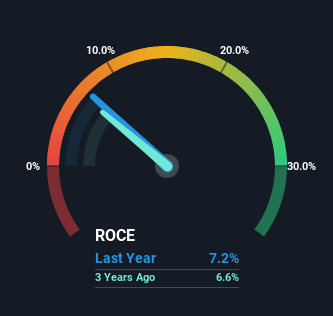Beijing Jingneng Thermal (SZSE:002893) Will Want To Turn Around Its Return Trends

There are a few key trends to look for if we want to identify the next multi-bagger. Firstly, we'll want to see a proven return on capital employed (ROCE) that is increasing, and secondly, an expanding base of capital employed. Put simply, these types of businesses are compounding machines, meaning they are continually reinvesting their earnings at ever-higher rates of return. Having said that, from a first glance at Beijing Jingneng Thermal (SZSE:002893) we aren't jumping out of our chairs at how returns are trending, but let's have a deeper look.
Return On Capital Employed (ROCE): What Is It?
If you haven't worked with ROCE before, it measures the 'return' (pre-tax profit) a company generates from capital employed in its business. To calculate this metric for Beijing Jingneng Thermal, this is the formula:
Return on Capital Employed = Earnings Before Interest and Tax (EBIT) ÷ (Total Assets - Current Liabilities)
0.072 = CN¥105m ÷ (CN¥2.0b - CN¥560m) (Based on the trailing twelve months to June 2024).
Therefore, Beijing Jingneng Thermal has an ROCE of 7.2%. On its own that's a low return, but compared to the average of 5.5% generated by the Machinery industry, it's much better.
View our latest analysis for Beijing Jingneng Thermal

Historical performance is a great place to start when researching a stock so above you can see the gauge for Beijing Jingneng Thermal's ROCE against it's prior returns. If you'd like to look at how Beijing Jingneng Thermal has performed in the past in other metrics, you can view this free graph of Beijing Jingneng Thermal's past earnings, revenue and cash flow.
What Can We Tell From Beijing Jingneng Thermal's ROCE Trend?
Unfortunately, the trend isn't great with ROCE falling from 9.6% five years ago, while capital employed has grown 49%. Usually this isn't ideal, but given Beijing Jingneng Thermal conducted a capital raising before their most recent earnings announcement, that would've likely contributed, at least partially, to the increased capital employed figure. The funds raised likely haven't been put to work yet so it's worth watching what happens in the future with Beijing Jingneng Thermal's earnings and if they change as a result from the capital raise.
On a related note, Beijing Jingneng Thermal has decreased its current liabilities to 28% of total assets. So we could link some of this to the decrease in ROCE. What's more, this can reduce some aspects of risk to the business because now the company's suppliers or short-term creditors are funding less of its operations. Some would claim this reduces the business' efficiency at generating ROCE since it is now funding more of the operations with its own money.
The Bottom Line
In summary, Beijing Jingneng Thermal is reinvesting funds back into the business for growth but unfortunately it looks like sales haven't increased much just yet. Additionally, the stock's total return to shareholders over the last five years has been flat, which isn't too surprising. On the whole, we aren't too inspired by the underlying trends and we think there may be better chances of finding a multi-bagger elsewhere.
If you want to know some of the risks facing Beijing Jingneng Thermal we've found 3 warning signs (1 makes us a bit uncomfortable!) that you should be aware of before investing here.
While Beijing Jingneng Thermal may not currently earn the highest returns, we've compiled a list of companies that currently earn more than 25% return on equity. Check out this free list here.
Valuation is complex, but we're here to simplify it.
Discover if Beijing Jingneng Thermal might be undervalued or overvalued with our detailed analysis, featuring fair value estimates, potential risks, dividends, insider trades, and its financial condition.
Access Free AnalysisHave feedback on this article? Concerned about the content? Get in touch with us directly. Alternatively, email editorial-team (at) simplywallst.com.
This article by Simply Wall St is general in nature. We provide commentary based on historical data and analyst forecasts only using an unbiased methodology and our articles are not intended to be financial advice. It does not constitute a recommendation to buy or sell any stock, and does not take account of your objectives, or your financial situation. We aim to bring you long-term focused analysis driven by fundamental data. Note that our analysis may not factor in the latest price-sensitive company announcements or qualitative material. Simply Wall St has no position in any stocks mentioned.
About SZSE:002893
Flawless balance sheet with solid track record.
Market Insights
Community Narratives



